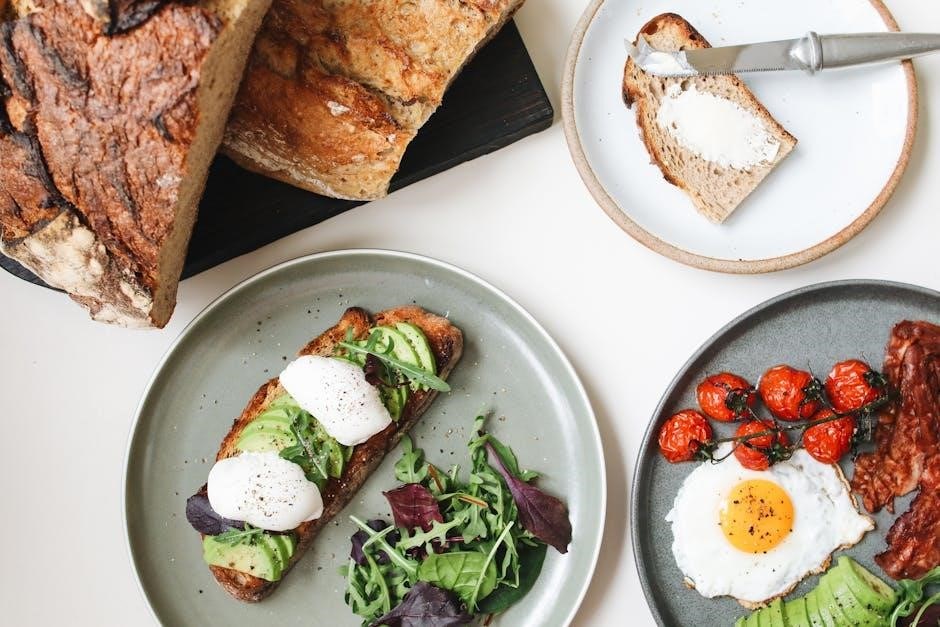Sourdough bread is a traditional, artisanal bread known for its tangy flavor and chewy texture, made using a natural starter instead of commercial yeast. Its unique taste and homemade charm have made it a favorite among bakers and food enthusiasts worldwide. The fermentation process promotes gut health, creating a nutrient-rich loaf. Sourdough baking brings families together and offers a sense of accomplishment. Whether you’re a novice or experienced baker, the joy of crafting homemade bread is unmatched, making the effort and patience worthwhile for that perfect, tangy loaf.
Overview of Sourdough Bread
Sourdough bread is a traditional, fermented bread made using a natural starter culture instead of commercial yeast. It relies on wild yeast and lactic acid bacteria present in the starter, which ferments the dough over a longer period. This process gives sourdough its distinctive tangy flavor, chewy texture, and thick crust. Each starter is unique, contributing to the bread’s characteristic taste and aroma, making it a beloved choice for artisanal bakers and enthusiasts alike.
Importance of Using a Sourdough Starter
A sourdough starter is a fermented mixture of flour and water teeming with wild yeast and lactic acid bacteria. It acts as the natural leavening agent, replacing commercial yeast. The starter’s bacteria ferment sugars, producing lactic acid for the bread’s tangy flavor and acetic acid for its aroma. Regular feeding maintains its health, ensuring robust fermentation and a light, airy texture. A vibrant starter is the heart of sourdough bread, defining its unique character and complexity.
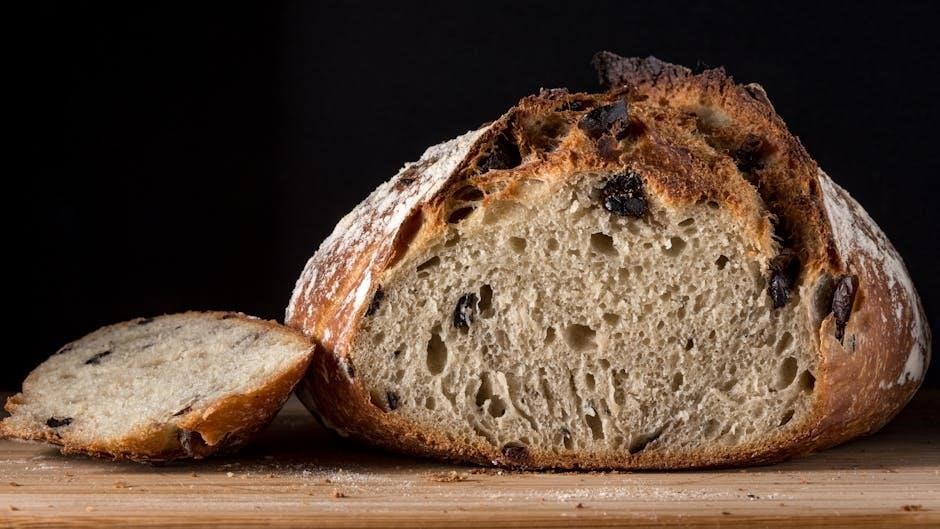
Creating and Maintaining a Sourdough Starter
Creating a sourdough starter is simple yet rewarding. Mix flour and water to foster wild yeast and bacteria, allowing it to ferment naturally. Patience is key as it develops over days, becoming bubbly and active—essential for authentic sourdough bread. This natural process is the foundation of traditional bread-making, ensuring a unique flavor and texture in every loaf.
Steps to Create a Sourdough Starter
To create a sourdough starter, mix equal parts of flour and filtered water in a clean glass or ceramic container. Cover it loosely and let it rest in a warm, draft-free place. Over the next few days, it will begin to bubble and emit a sour smell, indicating fermentation. This natural process harnesses wild yeast and bacteria, forming the foundation of your starter. Regular feeding with fresh flour and water will keep it active and healthy for baking.
Feeding and Maintaining the Starter
Feeding your sourdough starter involves discarding half of it and adding fresh flour and water daily, using a 1:1:1 ratio. This keeps the starter active and balanced. Regular feeding ensures it remains healthy and robust, ready for baking. Store it in a cool place or refrigerator if not used frequently, feeding it once a week to maintain its vitality and performance.
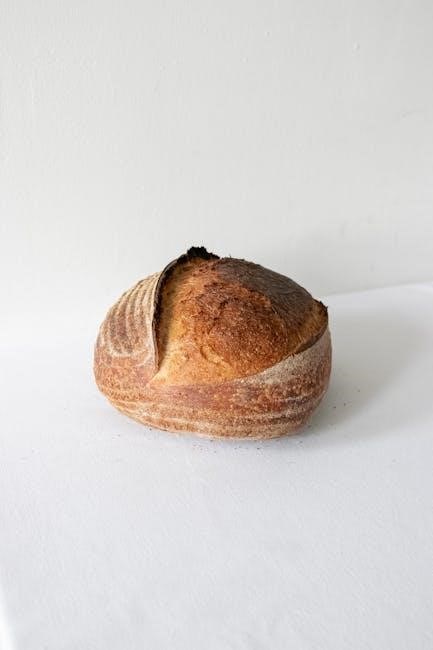
Essential Ingredients for Sourdough Bread
The core ingredients are bread flour, water, salt, and a sourdough starter. High-protein flour provides structure, while water hydrates the dough. Salt enhances flavor, and the starter ensures natural fermentation, avoiding commercial yeast for authenticity and unique taste.
Core Ingredients and Their Roles
The core ingredients for sourdough bread include high-protein bread flour, which provides structure and elasticity to the dough. Water hydrates the flour, initiating the breakdown of starches. Salt enhances flavor and controls yeast activity. The sourdough starter, a natural mixture of wild yeast and bacteria, ferments the dough, producing lactic acid and creating the bread’s signature tangy flavor and chewy texture. Each ingredient plays a vital role in achieving the bread’s characteristic taste and texture.
Quality and Sources of Ingredients
Using high-quality ingredients is crucial for achieving authentic sourdough bread. Opt for unbleached, high-protein bread flour for better structure and fermentation. Filtered water ensures proper hydration and flavor development. A healthy, active sourdough starter is essential, as it drives fermentation and imparts the bread’s signature tang. Sourcing fresh, unprocessed ingredients guarantees a more robust and complex flavor profile, enhancing the overall baking experience and final product quality.
Necessary Tools for Sourdough Bread Making
Essential tools include a mixing bowl, dough scraper, and Dutch oven for baking. Optional tools like a stand mixer or proofing basket enhance efficiency and quality.
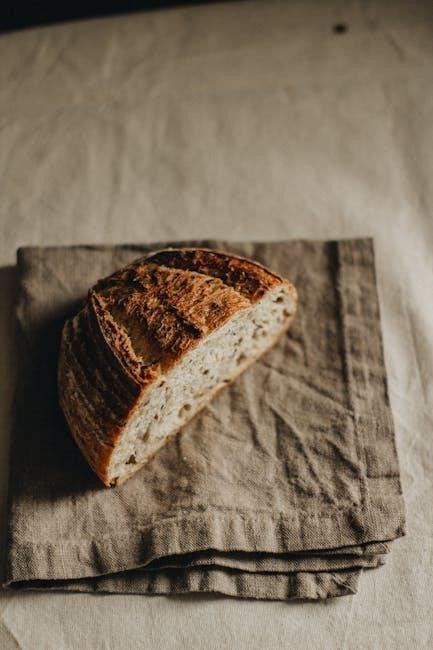
Basic Tools Every Baker Needs
A large mixing bowl, measuring cups, and a dough scraper are essentials for handling sticky dough. A Dutch oven or baking stone is ideal for achieving a crispy crust, while parchment paper simplifies transferring the dough. A sharp knife or lame is necessary for scoring the bread, ensuring proper expansion during baking. These tools are fundamental for crafting a perfect sourdough loaf.
Optional Tools for Enhanced Baking
A stand mixer can streamline mixing and kneading, while a proofing basket or banneton helps shape the dough evenly. A dough whisk simplifies mixing, and a bench scraper aids in handling sticky dough. These tools enhance efficiency and precision, allowing for a more refined baking experience without being essential for the basic process.
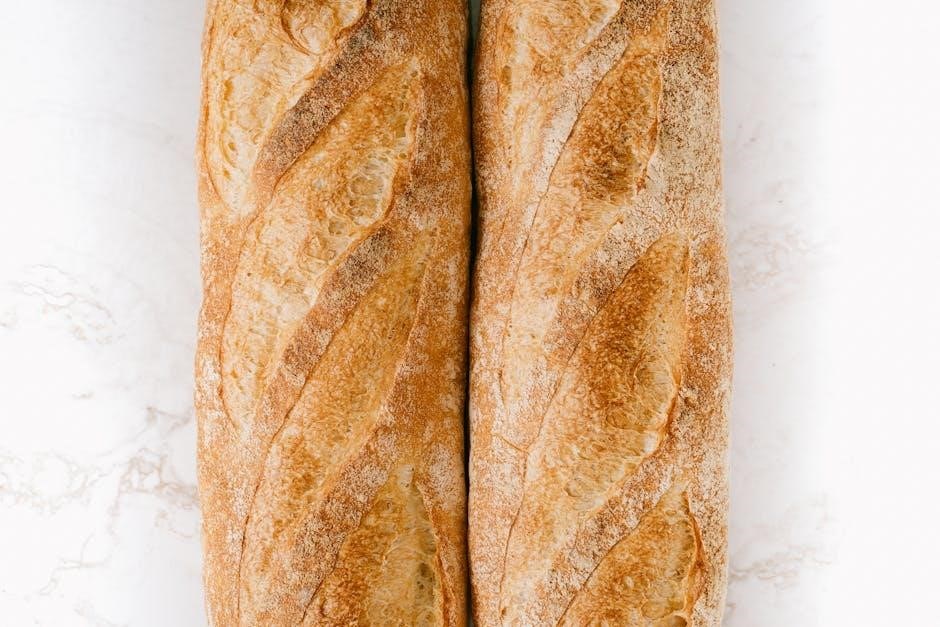
The Fermentation Process
Fermentation is the heart of sourdough bread-making, where the natural yeast and bacteria in the starter break down sugars, producing lactic acid and carbon dioxide. This slow process gives sourdough its tangy flavor and chewy texture, developing a bubbly, airy structure over hours.
Understanding Autolyse and Bulk Fermentation
Autolyse is the initial step where flour and water mix, allowing starches to break down. This hydration process typically lasts 20-30 minutes, enhancing dough structure. Bulk fermentation follows, where the dough rests, developing flavor and texture. The sourdough starter ferments sugars, producing lactic acid and CO2, which creates bubbles and strengthens the dough, preparing it for shaping.
Factors Affecting Fermentation
Temperature, starter activity, and dough hydration significantly impact fermentation. Warmer environments speed up the process, while cooler temperatures slow it down. An active, healthy sourdough starter ensures robust fermentation. Proper dough hydration balances the process, preventing overly dense or dry loaves. Monitoring these factors ensures optimal fermentation, achieving the desired rise and flavor in sourdough bread.
Baking the Perfect Sourdough Loaf
Preheat your oven to 475°F with a Dutch oven inside. Use steam by adding ice cubes for a crispy crust. Bake at 475°F for 30-40 minutes, ensuring a golden, crackling loaf with a light, airy interior. Proper steam and temperature are key to achieving the perfect sourdough texture and flavor.
Preparation for Baking
Preheat your oven to 475°F (245°C) with a Dutch oven or baking stone inside. Lightly dust a parchment-lined peel or inverted baking sheet with cornmeal. Gently place the shaped dough onto the prepared surface, ensuring minimal handling to preserve air pockets. Score the bread with a sharp blade or razor, creating 2-3 diagonal cuts. Once the oven is preheated, carefully transfer the dough to the hot Dutch oven or stone. Add ice cubes to the oven for steam, then bake.
Techniques for Achieving the Ideal Crust
Achieving the perfect sourdough crust requires precise techniques. Preheat your oven to 475°F (245°C) with a Dutch oven or baking stone inside for even heat distribution. Introduce steam by adding ice cubes to the oven, which enhances crust development. Score the dough deeply with a sharp blade or razor, making 2-3 diagonal cuts to guide expansion. Bake covered for 30 minutes, then uncovered for 15-20 minutes to achieve a golden, crispy crust. Monitor the internal temperature, aiming for 205-210°F (96-99°C). Let the bread cool on a wire rack for at least 1 hour to maintain crust texture and prevent sogginess.
Health Benefits of Sourdough Bread
Sourdough bread offers numerous health benefits due to its natural fermentation process. It contains gut-friendly bacteria like lactobacillus and acetobacillus, which aid digestion and boost nutrient absorption. The slower fermentation enhances the bread’s nutritional profile, making it easier to digest than traditional bread. Additionally, sourdough’s lower glycemic index makes it a healthier choice for blood sugar management. Its unique, tangy flavor and dense texture also set it apart from conventional bread, making it a favorite for health-conscious food lovers.
Nutritional Advantages
Sourdough bread offers enhanced nutritional benefits due to its natural fermentation process. It contains beneficial bacteria like lactobacillus and acetobacillus, which improve digestion and nutrient absorption. The slower fermentation breaks down phytates, increasing bioavailability of minerals like iron, zinc, and magnesium. Its lower glycemic index aids blood sugar control, while the presence of lactic acid reduces gluten content, making it easier to digest. This makes sourdough a nutrient-rich, healthier alternative to traditional bread.
Gut-Friendly Properties
Sourdough bread is renowned for its gut-friendly properties, primarily due to the presence of beneficial bacteria like lactobacillus and acetobacillus in the sourdough starter. These bacteria ferment sugars, producing lactic acid, which aids digestion and supports gut health. The slower fermentation process breaks down gluten, making the bread easier to digest and reducing inflammation. Additionally, the bread’s lower pH level acts as a natural preservative, promoting the growth of beneficial gut bacteria and enhancing overall digestive well-being. This makes sourdough a superior choice for those seeking a gut-friendly bread option with unique flavor and aroma.
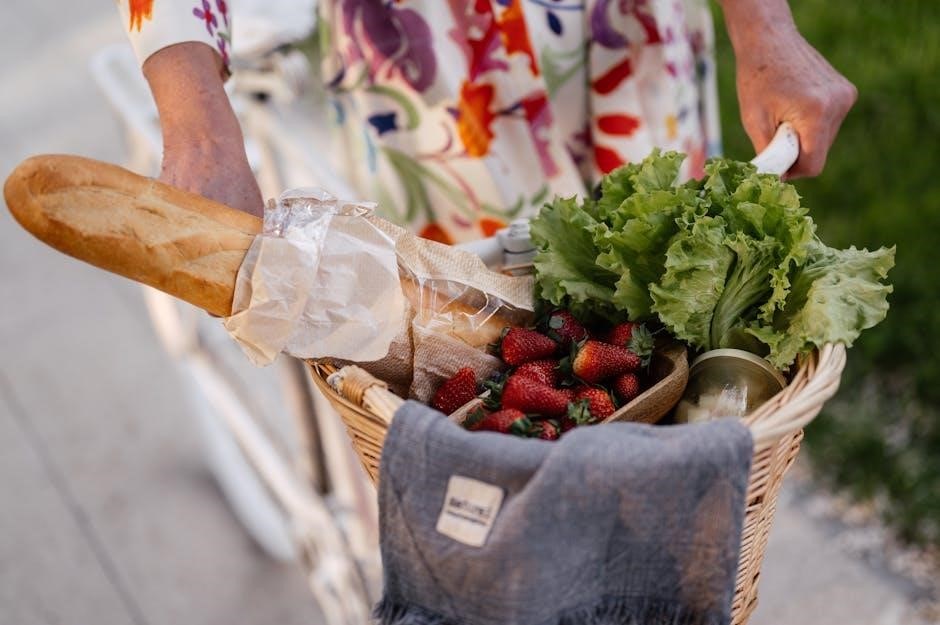
Advanced Techniques and Variations
Exploring unique flours, adjusting hydration, and refining proofing times can elevate your sourdough game. Incorporate add-ins like nuts, seeds, or herbs for distinct flavors, or try intricate designs for a personalized touch, allowing customization to suit various tastes and dietary preferences while keeping your baking journey fresh and exciting.
Exploring Different Flours and Add-Ins
Venture beyond traditional bread flour by incorporating whole grains, rye, or ancient flours like spelt or Kamut. Add-ins such as nuts, seeds, herbs, or dried fruits can enhance texture and flavor. Even olive oil or honey can elevate your loaves. These variations allow you to create unique, nutrient-rich sourdough breads that cater to diverse tastes and dietary preferences, keeping your baking journey fresh and exciting.

Adjusting Hydration and Proofing Times
Mastering hydration levels and proofing times enhances sourdough complexity. Higher hydration yields a more open crumb, while lower hydration produces a denser loaf. Proofing times can be shortened for a milder flavor or extended for deeper tang. Temperature plays a key role—warmer environments speed fermentation, while cooler ones slow it down. Adjusting these elements allows for customization, ensuring each loaf meets your desired texture and flavor profile.
Troubleshooting Common Issues
Common sourdough issues include inactive starters, overmixing, and incorrect temperatures. Ensure your starter is active, avoid overmixing dough, and maintain consistent proofing conditions for optimal results.
Identifying and Solving Problems
Identify common issues like an inactive starter or overproofed dough by observing texture and behavior. Solve problems by adjusting feeding schedules, ensuring proper hydration, and maintaining consistent temperatures. Regularly inspect your starter for bubbles and a tangy aroma, signs of health. For dense bread, check proofing times and dough handling. Adjustments can prevent common pitfalls, ensuring a perfect loaf every time; Patience and observation are key to mastering sourdough troubleshooting.
Optimizing Your Baking Environment
Optimize your baking environment by maintaining consistent temperatures and humidity. Use a Dutch oven or baking stone for steam retention and crust development. Preheat thoroughly and add ice cubes for steam. Ensure proper ventilation and draft-free proofing areas. Regularly maintain tools and equipment for efficiency. A controlled environment enhances fermentation and baking results, helping you achieve the perfect sourdough loaf with a crispy crust and airy interior.
Sourdough baking is a rewarding journey of patience and creativity. Embrace experimentation, keep practicing, and enjoy the process. Happy baking!
Encouragement for Continuous Learning
Continuous learning is key to mastering sourdough bread baking. Explore new techniques, experiment with different flours, and refine your process. Each batch offers a chance to improve and innovate. Join sourdough communities, share experiences, and stay inspired. With time and practice, you’ll develop a deeper understanding and appreciation for this artisanal craft, creating unique loaves that reflect your personal style.
Final Words on the Joy of Sourdough Baking
Sourdough baking is a rewarding journey that combines art and science, offering a sense of accomplishment with each successful loaf. The process fosters patience, creativity, and connection to tradition. As you bake, you’ll find joy in the simple, repetitive steps and the satisfaction of sharing homemade bread with loved ones. Embrace the process, enjoy the ride, and let the tangy aroma of sourdough bring warmth to your home and heart.
